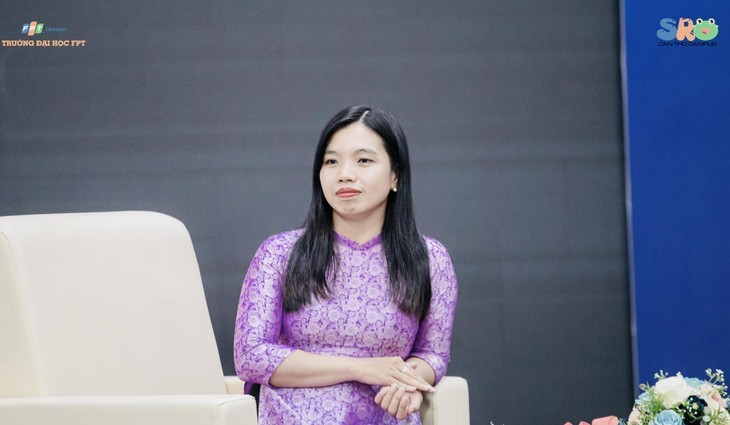(VOVWORLD) - Cai luong, or reformed opera, is the youngest of Vietnam’s traditional theatrical art forms. In recent years, cai luong and other traditional art forms have barely reached the vast majority of people. Dr. Dao Le Na, a lecturer from the Ho Chi Minh City University of Social Sciences and Humanities, has worked with a group of young people to find a breakthrough for cai luong.
 Dr. Dao Le Na in a talk with students of FPT Can Tho about the “Doi Kieu” play (Photo credit: Dao Le Na) Dr. Dao Le Na in a talk with students of FPT Can Tho about the “Doi Kieu” play (Photo credit: Dao Le Na)
|
Reporter: Welcome, Dr. Dao Le Na, to VOV. How long ago did you come up with the idea of launching a program to renovate cai luong?
Dr. Le Na: As a student, I collaborated with a number of TV stations, wrote skits and stage scripts, researched cai luong scripts, but hadn’t staged any scripts. After completing my doctoral thesis, I started a community art project called Yume Art, to spread art projects or art education projects to everyone, especially those who have little access to the arts, and to give young people information about the arts. The project lets young people talk to arts experts and researchers and lets me work with youths on traditional arts projects.
Reporter: I’ve heard Yume Art awakens the artistic potential within each person and inspires a passion for reformed opera among youths. How does it do that?
Dr. Le Na: Yume Art's first cai luong project, "Tiep buoc tram nam " (Following a Century-Old Tradition) teaches the art form to children and teenagers. We decided to write a reformed opera script and stage it after a survey of young people to answer the question “Why do youths find cai luong strange ?” helped me recognize the problems of cai luong in the contemporary context.
“Vai dien dau doi” (The first role in life) was the first script I wrote with one of my friends. It was adapted as a cai luong play by People’s Artist Bach Tuyet and performed by young people as part of the Yume Art project.
In the past, a cai luong performance lasted three to four hours. Nowadays young people have too little patience for such a long play. Young people say cai luong plays are old-fashioned and the stories aren’t relevant to their lives. And elderly cai luong actors playing youthful characters is difficult to believe.
The survey convinced me to create a cai luong play that would speak more directly to a youthful audience. I’ve introduced modern themes such as robots, computers, smartphones, and references to fake news – things young people encounter every day. And I shortened my play to an hour and a half and cast young actors. A play about students should be acted by students.
When the play was performed, young people who saw it said it felt very relevant to them. I think this is the direction that I will renovate cai luong.
Reporter: Your most recent play “Doi Kieu” (Waiting for Kieu) based on “Tale of Kieu”, the masterpiece of the 18th century great poet Nguyen Du, has been widely praised. Why did you decide to use cai luong to tell the story of Kieu?
Dr. Le Na: I made this play because I wanted to show everyone how the art form has changed, how the theater language has supported this play, and what young people are doing for cai luong with these innovations. In this play, I focused on the language of theatrical staging, so that when people watch it, they will see that without this or that scene, the play wouldn’t work. My aim was to use the cai luong idiom to tell the story of Kieu so viewers will see how beautiful the art form is.
 Nguyen Hong Bao Ngoc, a young artist who acts four characters – Thuy Van, Hoan Thu, Giac Duyen, and Dam Tien – in “Doi Kieu” cai luong play (Photo credit: Dao Le Na) Nguyen Hong Bao Ngoc, a young artist who acts four characters – Thuy Van, Hoan Thu, Giac Duyen, and Dam Tien – in “Doi Kieu” cai luong play (Photo credit: Dao Le Na)
|
Reporter: People who know the history of cai luong said that it was created because artists wanted to renew traditional theatrical art forms. You seem to be carrying that renewal even further.
Dr. Le Na: My play Doi Kieu (Waiting for Kieu) was an experimental step to help me decide the way I should continue. In this play the character Kieu is played by a 19-year-old actress. I cast her to appeal to a young audience and it worked out just as I thought. Young viewers were more excited about the play, and so were older viewers. The most important thing is to find truly good young actors and give them opportunities and their energy will rejuvenate the cai luong stage. I’ll continue to experiment with theatrical language because cai luong is a young art form that’s ready for innovation. In future plays, I plan to use experimental staging so everyone will see that cai luong is innovation, experimentation, and change. I hope that in my new play, an adaptation of the play “The first role in life”, the combination of physical drama and “boi”, or tuong singing, will attract a larger audience. That’s my direction for renewing cai luong. It will be a long journey and will require the help of many people.
Reporter: Thank you, Dr Le Na, for sharing with our audience!